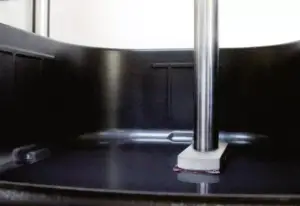| Defect Name | Phenomenon | Reason | Solution reference plan |
| Shrinkage cavity | The appearance of small circular pits or tiny white spots | The substrate has oil stains | Clean the substrate |
| Add improper diluent | Replace the thinner | ||
| The temperature is low, making it difficult for the paint to level smoothly. | Preheat the substrate to 35-50°C before construction | ||
| There is water, oil, etc., in the air pipe or spray gun. | Drain water and remove oil | ||
| Thicken | Increased paint viscosity | Evaporation of the diluent during storage | Keep sealed to prevent solvent evaporation. |
| High storage temperature | Store at 25°C in an air-conditioned room | ||
| Storage time is too long | First in, first out; use within the expiration date | ||
| precipitation | Sediment and clumping appear at the bottom of the barrel. | The solid components settle during storage | Stir or roll the paint frequently |
| Coarse grains, granules | The coating surface has a granular appearance. | The substrate is uneven and has burrs. | Substrate surface treatment and leveling |
| There are impurities in the paint | Select the appropriate filter screen for filtration | ||
| There are dust particles in the painting and baking environment | Clean spray and baking environment | ||
| Moisture absorption | After spraying, water droplets form on the surface of the wet film; water stains and mottling appear on the surface. | The coating is easily absorbent | Choose dry weather or environment for spraying |
| Preheat the substrate to 35-50°C before construction | |||
| After coating, put it into the oven as soon as possible. | |||
| Expose one’s bottom | The phenomenon of exposing the substrate color | Coating is too thin | Adjust to the appropriate viscosity |
| The paint has poor coverage. | Choose a paint with good coverage | ||
| Excessive dilution of paint during construction | Spray to the appropriate film thickness | ||
| Foaming | Blistering appears on the surface of the coating after sintering | The substrate is not cleaned properly and has grease. | Degreasing |
| The temperature rises too quickly, causing the solvent to evaporate instantly. | Reset the baking process | ||
| Too thickly sprayed | Control spray thickness | ||
| The paint application viscosity is too high | Readjust the spray coating viscosity | ||
| Peeling, poor adhesion | Poor coating adhesion, phenomenon of detaching from the substrate | The substrate is not properly cleaned and has oil. | Degreasing |
| The sintering temperature and time are incorrect | Check the furnace temperature and sintering time | ||
| Orange peel | Surface defect where the paint film exhibits an orange peel appearance | Construction viscosity is too high | Adjust the coating viscosity |
| Spray atomization, inappropriate pressure | Adjust air pressure and atomization | ||
| Hanging flow | A coating with uneven thickness at the lower edge is formed as the wet paint film moves downward into various shapes. | The paint application viscosity is too low | Adjust the spray viscosity, oil output, and pressure |
| Too thickly sprayed | Adjust the coating thickness | ||
| Low temperature or smooth substrate | Preheat the substrate to 35-50°C before construction | ||
| Apparent difference | Phenomena of coating dullness, yellowing, or darkening | The oven or tunnel furnace has poor exhaust ventilation. | Improve ventilation |
| The sintering temperature or time is incorrect | Check the furnace temperature and sintering time | ||
| The coating thickness is too thick or too thin | Adjust the spray coating thickness |
Skip to content
Skip to footer


